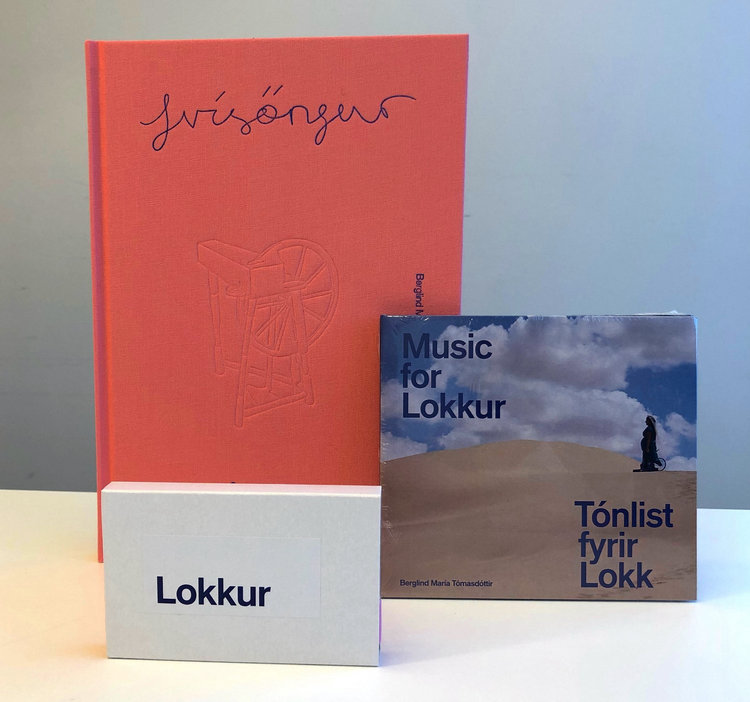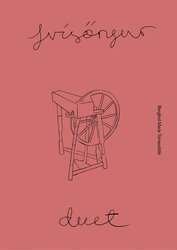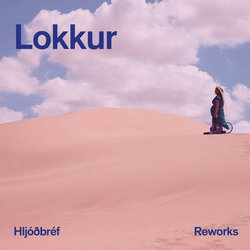Among the plethora of releases i’ve received in recent times there’s been a number of especially noteworthy items, either in the form of sizeable box sets or otherwise ‘unusual’ editions, so throughout the course of this month, alongside other things, i’ll be exploring some of them. Surely the strangest (and, in some respects, amusing of them) is The Lokkur Project by Icelandic flautist and experimental musician Berglind María Tómasdóttir. Let’s start with a bit of history, some real, some invented.
The origins of the project date back over a decade to around 2011, when Tómasdóttir was engaged in a fundamental questioning of her identity as a musician. Part of her explorations at that time involved The Trailer Project; having grown tired of the conventions of the concert hall, she instead took to travelling around Iceland giving intimate performances in trailers and caravans to audiences of no more than a handful of people at a time. This questioning of identity extended when Tómasdóttir moved to California to pursue her Ph.D., leading her to create an alter-ego named after the literal English translation of her name, Rockriver Mary, along with an elaborate backstory of Mary’s life as an Icelandic settler in the United States. In 2012, Rockriver Mary’s fictitious life was furnished with an equally fictitious instrument, the hrokkur, constructed from the unlikely combination of the back end of a bike attached to a guitar, its name derived from the Icelandic words ‘hjól’ (bicycle) and ‘rokkur’ (spinning wheel).

Tómasdóttir’s work from this period can be explored in depth in a variety of media. A short video, The Origin of Things (2012), demonstrates her playing the hrokkur in the landscape, and the instrument features on an EP, I’m an Island, released the same year. A diary of The Trailer Project can be found in Tómasdóttir’s Rockriver Mary blog, expanded in a 20-minute film, The Caravan Concerts, created in 2013, and the entirety of this musical journey is discussed in great detail in the dissertation accompanying Tómasdóttir’s Ph.D., also completed in 2013.
More recently, the backstory has been fleshed out further to incorporate the evolution of the hrokkur into the lokkur, still wielded by Rockriver Mary but now as a somewhat more sophisticated instrument resembling, both physically and aurally, the conjunction of a spinning wheel with the traditional Icelandic langspil (a type of zither). While Tómasdóttir’s previous work took the form of an experiment, feeling her way forward during a time of personal uncertainty, the results of The Lokkur Project seem much more consolidated and confident, underlined by the recent three-fold presentation of the project’s first definitive fruits, in the form of a book, a CD and a cassette.


The book – and, indeed, the project as a whole – brings to mind another extensive work of playful musical fiction, Jennifer Walshe’s Historical Documents of the Irish Avant-Garde. Titled Tvísöngur (Duet), it functions as a hypothetical Socratic dialogue between the parallel, body-sharing characters of Tómasdóttir and Rockriver Mary. In the course of their conversation, the whole project from its origins to now is discussed, elaborating on both its reality and its fiction. We learn that its real-world inspiration in part came from Tómasdóttir’s desire “to play on an instrument that was closer to me and could be embraced, an instrument that one could play while talking, singing and eating”, and that the whole backstory was “inspired by the stories of Western Icelanders, people who fled Iceland in the period around 1900, seeking better living conditions in the Americas.” And this is just the start; though its tone is often humorous, even bawdy, Tvísöngur reveals more and more how the ostensibly mischievous aspects of this project are also deeply personal and serious. Just as with Walshe’s fictitious Irish pioneers, there’s no attempt here to deceive; the book’s discourse is rooted in its obvious artificiality, describing its invention and construction in great deal, festooned with a large number of pictures and diagrams.
The musical part of this project consists of two distinct sets of responses to the lokkur: the first acoustic, works composed for the instrument and performed by Tómasdóttir; the second electroacoustic, comprising pieces of electronic music utilising the instrument’s very distinctive sounds.

The six acoustic works, heard on the EP Music for Lokkur, have a lot in common, presenting a kind of faux-folk music that sounds new while simultaneously evoking a sense of semi-invented historical practice. Tómasdóttir’s contributions, Lokkur I and II (two performances of the same piece), are almost like demonstrations, highlighting the key characteristics of the instrument, specifically the cranking and rhythmic pulse arising from the rotation of the wheel, plus an occasional burst of rapid ticking (akin to something striking the spokes of a wheel), the fundamental drone and other sustained tones, and plucked or struck notes loosely forming a pointillist melody.
Three of the other pieces tap further into the folk credentials of the lokkur. Þórunn Gréta Sigurðardóttir’s Fátækt [Poverty] sets words by Jakobína Sigurðardóttir to create a hypnotic static song, the sung melody of which is reinforced by pizzicato notes. Sigurðardóttir segues from this into a second song, Langlínusamtal Við Fúskara [Long-distance conversation with Fúskar], featuring an earnest but amusing back-and-forth between two imaginary interlocutors, one distinguished by being articulated through a megaphone, while the lokkur drones and rotates underneath. This combination of the crude megaphone with the unchanging noise of the lokkur lends the song something of the qualities of an old wax cylinder recording, enhancing its impression of being an older folk music.
More engaging is Lilja María Ásmundsdóttir’s Undir Aski Yggdrasils [Beneath the World Tree], where two layers of material – faint wind, and bowed or struck pitches – are set up in parallel, later added to with a third layer of soft vocalise sung almost absent-mindedly, creating a surprisingly beautiful soundworld of gentle intimacy. Karólína Eiríksdóttir’s Leikur Hún Á Lokkinn — Hugsað Til Gamla Landsins [She plays the game – thought for the old country] does something similar, using the fast rotation of the lokkur to act as an implied more than actively present drone, over which lengthy melismas soar, embellished with plucked notes (at one point forming a countermelody) and ripples of light wheel clatter. There’s something almost incantatory or spell-casting about it, enacted through the physical actions of the wheel and aural actions of the voice; either way, the polarisation between the busy, hard-edged activity of the lokkur and the slow smoothness of the vocal line makes for a mesmerising effect.

Not surprisingly Lokkur Reworks, featuring ten electronic pieces, is more sonically adventurous and varied. In Dear Berglind, Rachel Beetz sets up an environment of soft noise inhabited by slow lokkur rotations and reverberant glancing tones. Harmonically and behaviourally static, its effect is highly meditative, though Beetz pulls the rug out later on by breaking it up through alternations of material and shifting away from pitch in favour of more mechnical clunk later on. Bergrún Snæbjörnsdóttir’s Allt eins og blómstrið — Remix is yet more immersive, almost like an installation piece in the way the actions of what sounds like a chorus of lokkurs play out seemingly independent of one another according to their own internal logic, building to a united wall of mechanical noise. The most stylistically unexpected piece is Kurt Uenala’s Weltraum Rework, where the lokkur’s wheel becomes the basis for a gentle metric pulse that for several minutes is allowed to drift to the accompaniment of strummed chords and hummed vocals, before opening out into a soft, rather lovely slice of electronica.
One of the highlights of the album is Lilja María Ásmundsdóttir’s Between the Branches, developing the ideas from her acoustic piece into something more elusive though strangely far more arresting, where distant bowed notes echo in a large space coloured by memories of the lokkur (at first briefly glimpsed; later more assertive) and Undir Aski Yggdrasils’ intimate vocal line. Berglind Tómasdóttir’s own Attractive stays closer to the lokkur, exploring a fascinating mix of regularity and randomness, overlaying the thumping action of the instrument with floating pitch ideas. Most ambitious and effective of all is Clint McCallum’s You Are a Flame Burning Blue, a 14-minute track populated by the austere sound of a deep, digital chorus chanting. Together with languid string ricochets – starting and stopping as if recorded on a tape being manipulated – this becomes the basis for an undulating vocal texture surrounded by light mechanical (and possibly / probably) electronic sounds that gradually grows and builds in intensity. A little over halfway through McCallum pulls things back slightly, entering a sequence of repose where only the lokkur continues, before suddenly and unexpectedly opening out the entire soundworld through the emergence of wow-inducing bass tones (which echo the undulation of the voices), leading to a glorious climax of transfixed ecstasy. The comedown from this apogee features the repetitions of the lokkur, winding down to nothing.
The Tvísöngur book, Music for Lokkur CD and Lokkur Reworks cassette are all available via Tómasdóttir’s Bandcamp site.

[…] when exploring flautist Berglind María Tómasdóttir’s album Ethereality and more extensive Lokkur project. In both cases Lilja María’s contributions were among the most interesting, and the […]